Archive for category Past issues
A Fascinating Scene at the Kollur Mookambika Temple
Posted by admin in January 2020, Past issues on February 20, 2020
By K S Venkataraman
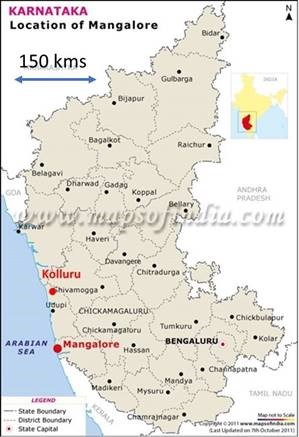
About 90 miles from the coastal city of Mangaluru in Karnataka is the famous Mookambika Temple in the Western Ghat forest. This temple has a fascinating history traceable all the way back to Adi Shankara. Devotees from all over South India, more from the neighboring Kerala State, come here to worship the presiding deity Mookambika as Saraswati, Lakshmi, and Durga. Because of this, aksharaabhyaasam, the ceremony initiating young kids into learning, is conducted all through the year. Young parents come here for this ceremony with their small children accompanied by their family elders. Last December, I was at the temple with my wife, and my elder daughter, her husband and her two kids for the ceremony for the grandkids.
Sitting with a bunch of people with their young kids, coming from diverse socioeconomic backgrounds, was uplifting. Parents and grandparents were squatting on the floor with their young wards. They knew the routine. The priest then placed in front of every child a brass plate with rice paddy spread evenly on the plate and a piece of turmeric root. He then recited Sanskrit hymns seeking divine grace for completing the ceremony of initiating the kids into studies.
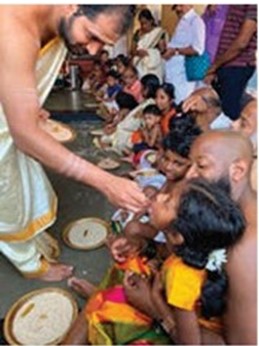
The priest then asked the father/mother/grandfather to hold the tender fingers of the young one sitting on their lap and write with the turmeric root the following: a aa, i, ii, u uu etc. — the Indian alphabets — in their native scripts like Malayalam, Tamil, Telugu, Kannada, Hindi… Then he asked the parents to write the numbers 1 to 10.
These steps made enormous sense. After all, civilizations are built around languages and mathematics. As the Good Old Tamil Grand Lady Ouvvaiyyar said over a millennia ago,

eNNum ezhuttum kaNNenattagum
meaning, “Numbers and letters are the two eyes on our face,” because they are necessary to acquire skills and make ourselves useful to others. Otherwise, we become a burden on society.
But the priest did not stop with initiating the young ones only to letters and numbers. He then did something unique and fascinating: he also asked the parents to help the kids to write sa, ri, ga, ma, pa, da, ni, the seven notes in Indian music, similar to do re mie fa solâ… …
What was the priest’s motivation for this step in the aksharaabhyaasam ceremony? He was indicating to parents that it is not enough to acquire skills to earn wealth as an end in itself, but also to cultivate interest in aesthetics like music, dance, literature… … both as practitioners and as patrons as well. After all, wealth and resources are for enjoying the finer aspects of life.
The priest conducting the ceremony himself was starkly simple in his demeanor and was by no means affluent. But he had a far better concept of how we should live our lives and use our resources. END
Home:
6th PIC-5k Run Brings the Indian Community Together Raising $60,000 for Local Causes!
Posted by admin in January 2020, Past issues on February 20, 2020
By Suresh Ramanathan, Volunteer, PIC-5k Organizers
Despite the ominous forecast, it turned to be perfect weather for runners and walkers, which later blossomed into a sunny afternoon! On Saturday, September 14, 2019, the Indian Community and Friends in all its diversity gathered at the North Park Boat House for the sixth year to celebrate the annual 5-k walkathon.
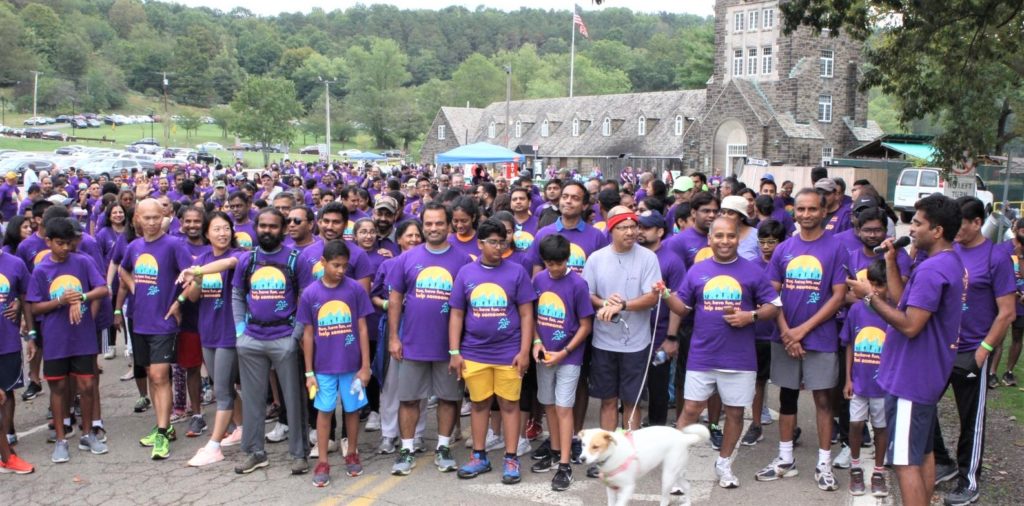
If you were one of the over 500 who attended, you probably enjoyed the ambience of the beautiful North Park Boat House area before you set off on a 5-k or 1-k walk or run around the placid lake. You may have even joined the yoga class to stretch and limber up before the national anthems began. Along the way you may have picked up a bottle of water or dawdled at the color station to create your own custom-designed purple shirt and make yourself even more colorful.
When you made your way back to the boat house you would have found bananas, clementines and piping hot Indian food waiting for you. As you listened to the results of the run and music and interacted with the various non-profits at their tables, your younger children got their faces painted or got Mehndi done for a small donation.
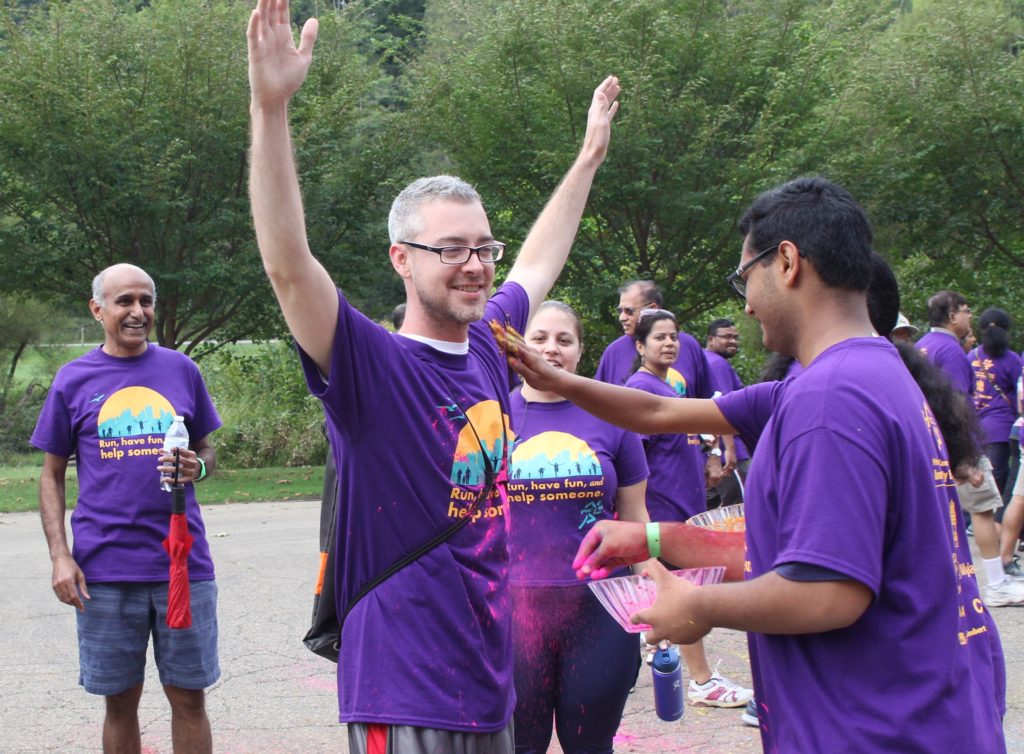
As you enjoyed the delicious food and walked around visiting various tables, you would have bought raffle tickets and dropped then into containers to win tickets to a great Indian music concert or to snag “the biker’s basket†from Pro Bike and Run or even tried your chance at winning a collection of wines. Even if you did not win any of the raffles, you went home with great memories, a striking T-shirt, knowing you came together with your community to make an investment in the lives of people in our region.
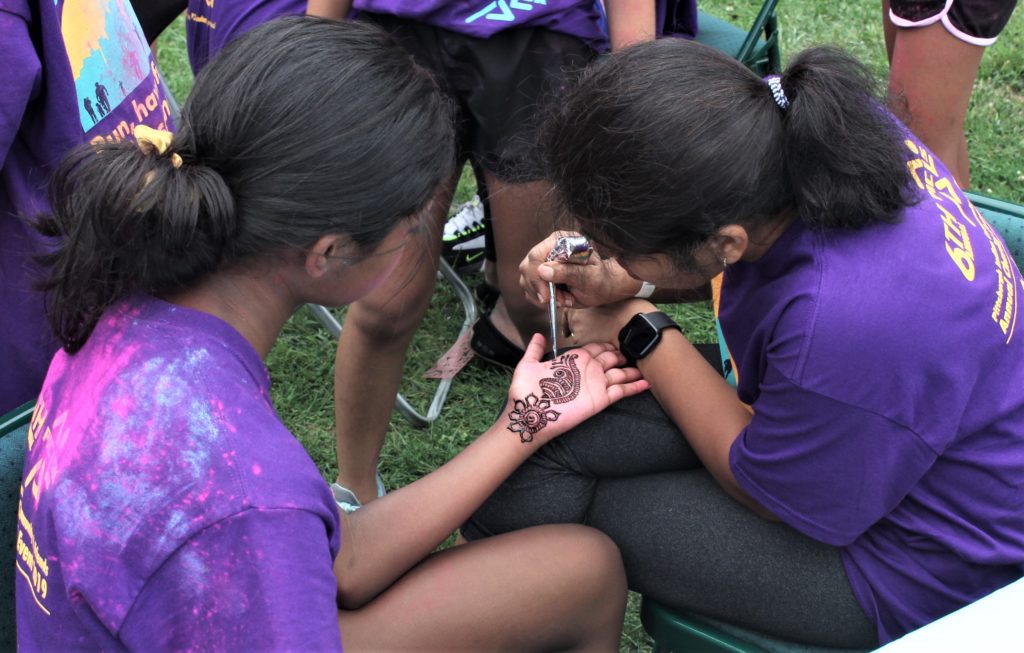
September is Hunger Action Month! The Pittsburgh Indian Community and Friends partnered with the Greater Pittsburgh Community Food Bank to support the “Breakfast Challenge†at 74 target schools across 11 counties in our region. In addition, we are partnering directly with some schools. As with other causes, this year too 100% of what is invested goes to programs, with not a red copper penny going to administrative overheads.
The PIC-5k event this year raised around $60,000. bringing the total over the 6-year period to $310,000. Over the last five years, the Pittsburgh Indian Community and Friends has invested over $260,000 in our own community in the areas of homelessness, education, healthcare and first responders. All this would not be possible without your involvement as supporters, donors, volunteers and sponsors. Thank you! END ï®
Home:
SPIFPA’s 2019 Cultural Festival
Posted by admin in January 2020, Past issues on February 20, 2020
By Radha Rao Dhulipala, Fox Chapel, PA
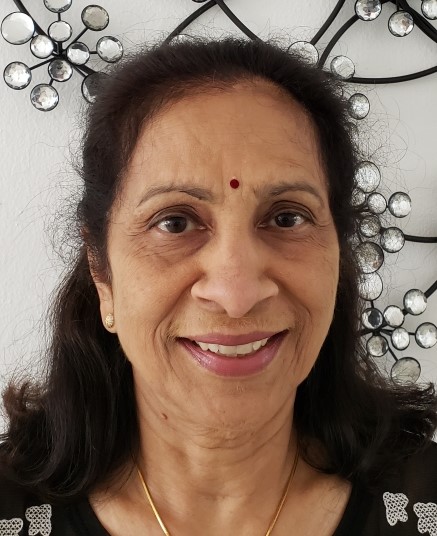
Radha Rao, a long-time resident in our area known to many, was born and raised in Chirala, a coastal town in Andhra Pradesh, India. After marrying Madhusudhan Rao, she moved to Pittsburgh in 1969. With her bachelors’ degree from Andhra University, and an MBA from Pitt, she worked at Carnegie Mellon University for 25 years. She is retired now. She volunteers at the S.V. Temple. She fondly recalls taking to Duquesne University decades ago for getting the 30-minute Music from India program on 90.5 FM.
Srinivasa Prasad International Foundation for Performing Arts (SPIFPA) hosted its 2019 Pittsburgh Cultural Festival of South Asian Performing Arts on Sunday, October 6th at the Fox Chapel Area High School Auditorium. Varaprasad and Parvathi Gutti of Latrobe, long-time residents and enthusiastic patrons of Indian performing arts for decades here, established SPIFPA as a non-profit 501 C (3) in 2005 in loving memory of Vasu (Srinivasa Prasad), their beloved son. Vasu, a passionate enthusiast of Kuchipudi and other Indian dance forms, died in a freak auto accident in 2004 and it was Vasu’s ambition to promote South Asian performing arts among North American youth.
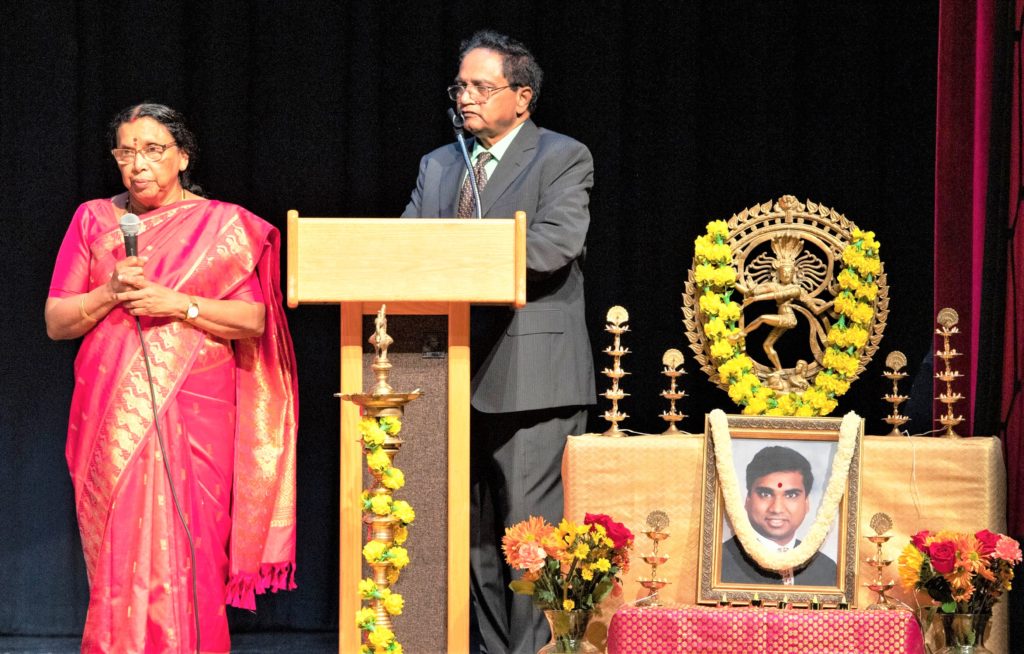
A few hundred people attended this day-long event, where more than ten dance and music schools from the greater Pittsburgh area show-cased the talents of their teachers and students.
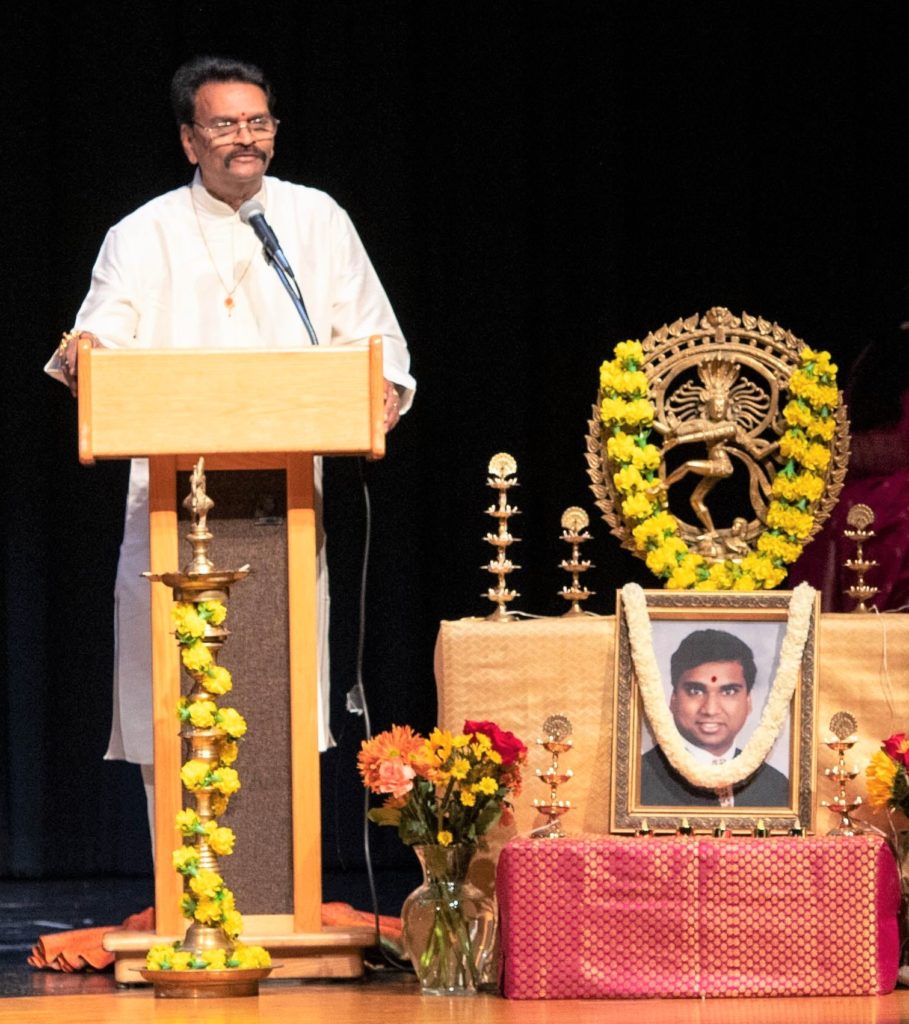
Inaugural session started with Deeparadhana and Invocational songs rendered by Sitalakshmi Madhavan, Saraswathi Chelluri, Sujana Mulukutla, Sheela Ganesh and Subha Sriram. They were accompanied by Shankar Krishnamurthy & Apoorva on violin, and Ganesh Iyer & Arjun on Mridangam. It was followed by Shri Varaprasad Gutti’s introduction of the Chief Guest for the event, Veena Vadya Vidya Visharada Sri Ayyagari Shyamasundaram from Andhra Pradesh, India. As part of the invocation session, Vasanta Krishna Lakkimsetty (Vasu’s niece) presented a touching Premanjali in the Kuchipudi style, memorializing Srinivasa Prasad Gutti. It certainly brought back several fond memories of Vasu to those who knew him.
In the forenoon session, artistic directors and students from Jaya Mani’s School of Bharatanatyam Dance (Director, Prof. Jaya Mani), Sitalakshmi Madhavan’s School of Karnatic Music (Director, Sitalakshmi Madhavan), SPIFPA School of Kuchipudi Dance (Director, Bindu Madhavi Gutti Rachuri), and Nandinik Dance Academy (Director, Nandini Mandal) presented their skills.
All the artistes and guests were treated to a sumptuous lunch during the mid-day break.
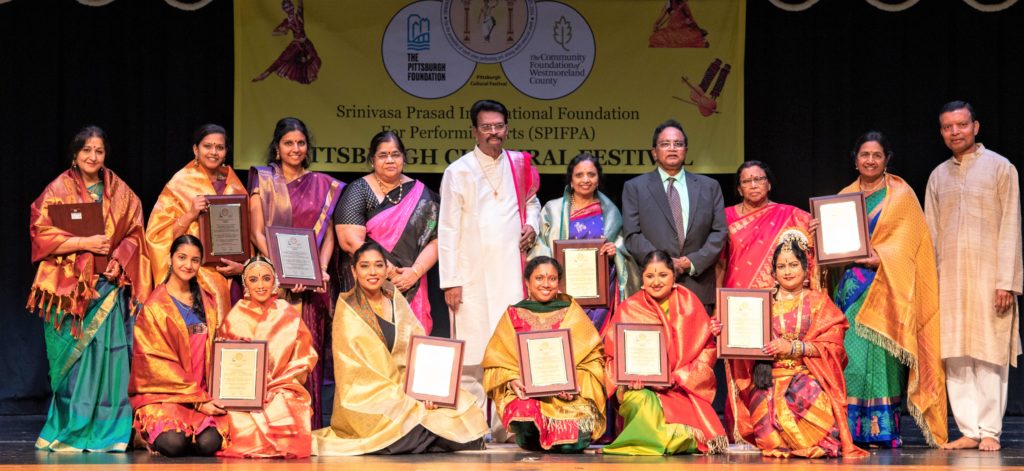
In the afternoon session, artistic directors and students from Natyakriya School of Bharatanatyam Dance (Director Shobhita Ravi), Sangeetha Saramaya School of Karnatic Music (Director Sujana Mulukutla), Sheela School of Carnatic Music (Director, Sheela Ganesh), University of Pittsburgh Team Pitt Nrityamala (Directors, Jothika Gorur & Nithya Kasibhatla), Courtyard Dancers of Kathak Nritta (Director, Niana Roychowdhury Green), Nritya Sumanjali Academy of Kuchipudi Dance (Director, Sumalatha Sri Ramoju) and Sanskruti School of Indian Dance and Music (Director, Shambhavi Desai) showcased their talents.
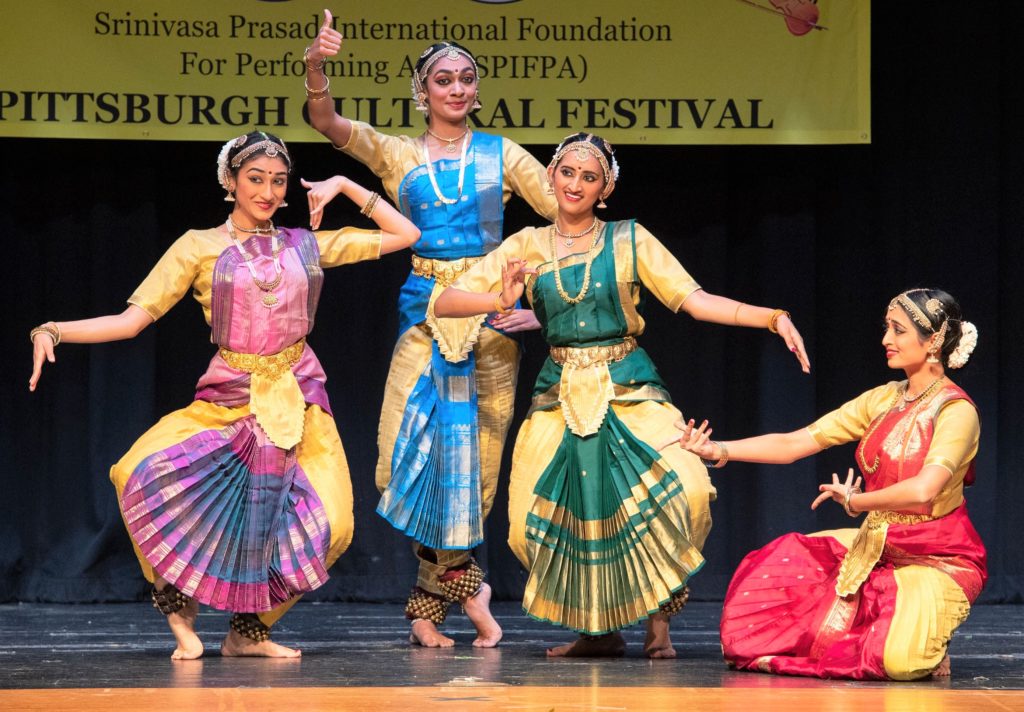
The highlight of the day was Sri and Smt. Gutti facilitating the Chief Guest Sri Ayyagari Shyamasundaram. Following the felicitation, Sri Shyamasundaram responded to the felicitation with a melodious veena recital which concluded the cultural program. SPIFPA honored all the gurus and artists that enriched the festival with their participation and presentations.
No doubt all the guests were treated to several Vindus or feasts (Vindu in Telugu and Virundu in Tamil) that day – Veenula Vindu (musical feast for the ears), Kannula Vindu (dance feast for the eyes), followed by a Vindu Bhojanam (grand Indian feast).
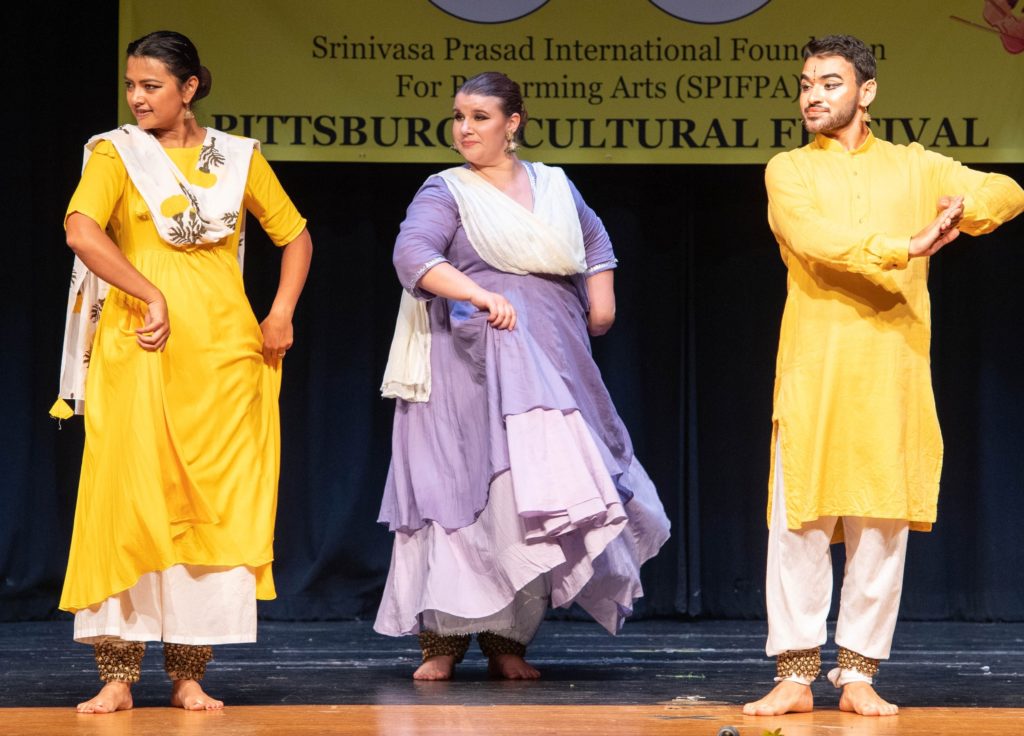
SPIFPA did a marvelous job in planning and executing this year’s program, which required lots of logistical details in managing the stage and lighting for all the different programs. I am happy to acknowledge the dedicated team of volunteers working on stage and back stage, taking care of all the needs of the artistes and guests. END ï®
Home:
Obituary: Om Sharma 1942 to Nov 1, 2019
Posted by admin in January 2020, Past issues on February 20, 2020
By Ramona Sahni, Pittsburgh, PA
Editor’s Note: Ramona Sahni is a long-time family friend of the Sharmas.
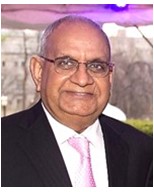
Om was born in Haryana, India on February 28, 1942 into a traditional Haryanvi family. He was the oldest of four siblings. His schooling was in Jaipur, Rajasthan, India followed by a degree in mechanical engineering from the University of Kashmir. This was followed years later by a master’s degree in mechanical engineering from the University of Pittsburgh.
Steel captivated Om. His first job was with a Birla company in Jaipur, where he worked for five years. During this time, he married Krishna in a traditional wedding and they had their three children: Sheeno, Mona, and Vickrant.
After installing a brand-new machine from Germany for the Birla company, he got an offer he couldn’t refuse from Tata Iron and Steel Works in Jamshedpur. After working there for eight years, in 1978, he saw that he had reached the ceiling for his career advancement.
The Sharmas immigrated to the United States in 1978. He had interviews in San Francisco, Detroit and Pittsburgh. Like some of us, while he was flying over the hills, valleys and rivers of our beautiful city, he felt a sense of home, remembering his young days in Kashmir. So here he was, from one steel city in India to another steel city in the United States! The Sharmas have stayed here ever since.
He started with Pennsylvania Engineering and later worked at Westinghouse. In 1983, he took a leap of faith and went into the steel business for himself. He founded Sherman International dealing with various aspects of steel, doing business across the globe.
He enjoyed music, poetry and singing. He always had a joke to tell, especially Haryanvi jokes. He had a passion for life, living each day to its fullest. He and Krishna travelled extensively, often to my amazement and concern, when he admitted he was being eaten within by his disease. Such was his courage and fortitude!
Om was an adoring father, willing to spend the night standing in line to buy coveted concert tickets for his young daughters. He was a doting husband who loved to sing “jo tum ko ho pasand, wohi baat kahenge, tum din ko kaho raat to raat kahenge†to his wife Krishna of over 50 years!
When I asked one of his long-term friends what he liked most about Om, he said, it was his genuineness. This was attested to by a number of people who attended his funeral on November 3, and by the daily satsangs held at his home, culminating in the traditional pagadi rasam, held 13 days later, at the Indian Community Center in Carnegie, which he helped establish.
A man is remembered by the legacy he leaves behind. Om will be remembered not so much for building a successful business or for his charitable contributions to the Hindu Jain Temple, The Encyclopedia of Hinduism, or to institutions like our own Phipps Conservatory, but for the place he carved for himself in the hearts of friends like me.
Pandit Suresh Chandra Joshi from the Hindu Jain Temple conducted the Vedic cremation for Om Sharma on November 3, helping Vickrant, Mr. Sharma’s son, with the cremation rites at the Beinhauer Family Funeral Home, Pittsburgh. Om Sharma is survived by his wife, Krishnaa, all three of his siblings, three children and six very talented grandchildren. END ï®
Home:
My Mataji’s (Mom’s) Kitchen
Posted by admin in January 2020, Past issues on February 20, 2020
By Juginder Luthra, Weirton, WV
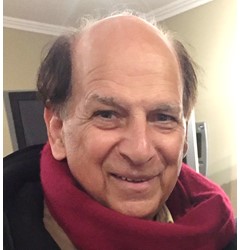
Each one of us gulped down the butter covered fresh rotis with steaming sabzi (cooked vegetable dishes) coming out of the kali covered brass kadaai (wok), lovingly served with mataji’s strong hands and loving eyes. The smile in the eyes matched the one on her full lips.
“Do you have more gobhi?”, even though the rotis were delicious enough alone and the answer was always “yes”. Gobhi is cauliflower in north Indian languages.
We did hear the ladle scraping the walls of the kadaai, which got quickly shielded by a metal cover with a small handle in the middle, which she held with the outstretched end of white sari.
“Eat, there is plenty more,â” she would say. We suspected it to be a lie, but the empty stomachs and young minds were too selfish to worry about her. And she loved our selfishness.
“Toon changa khada mainun aape mil gaya.” I remember her telling us in Punjabi, our mother tongue. “You ate well, it got to me automatically.”
Later, with a satisfied look in those loving eyes surrounded by wrinkles of worries and joy, she took two dry rotis, rubbed them on the katori (a small cup for serving dishes in dinner) which just a few moments ago was overflowing with the home-made white butter she made before the sunrise that morning by churning the home-made dahi (yoghurt).
Placing the rotis on a small steel plate, she crushed a small oval red onion between her two hardened palms, which, years ago, were softer than rose petals. The smaller onions were not pungent, especially the oval central core of the tender ones, unlike the larger ones, which are hard to crush and make your eyes tear. These were not as delicious.
“Somehow onions and humans are not much different,” she occasionally mentioned stoically.
She then pulled out a couple of dripping mango achaar (pickle) slices, also home-made, from the tall pale ceramic jar. Now, with the satisfaction of having nourished her family with food and love, she sat on the cloth woven chauki (a small low-height stool), folded her legs and put the plate on her knees. She scraped the few burkis (roti pieces) along the side of kadai till she could see the shiny walls of the kadai. The rest was enjoyed, relishing it with raw onion and achaar. She ate alone, in peace.
Her husband, our pitaji (dad), also was eating alone in some remote place working in a brick kiln; making barely enough money for his family to survive, helpless victims of the monstrous problems arising out of the 1947 Partition, in which the British in great haste slit India into India and Pakistan, causing misery and mayhem for millions in the Indian subcontinent, thus transforming a prosperous farmer in Pakistani Punjab into a brick maker near Delhi, and a well-to-do family into refugees overnight.
Mataji held the fort at home. With her family safe, well nourished with love and her food, she was content and happy in her kitchen. END
Home:
Mahatma Gandhi’s 150th Birthday
Posted by admin in January 2020, Past issues on February 20, 2020
By Antara Cleetus, South Hills, PA

Note: An 11th grader at Upper St. Clair High School, Antara Cleetus is a classical singer and dancer, and an occasional writer and painter. A member of her school’s speech and debate team, Antara believes in the power of words: spoken, sung, and written.
In 2009, former President Barack Obama was asked by a 9th grader, “Who would you most like to have dinner with, dead or alive?†Obama responded, “Gandhi, who’s a real hero of mine.†He also joked, “It would be a really small meal.â€
Nearly 100 years separate the births of these two leaders. Their homes, nearly 7,000 miles apart. Yet, none of this matters in light of Mahatma Gandhi’s global, powerful, and timeless reach. This anecdote related by the emcee, Maneesha Kumar-Cleetus, set the tone for the evening and captured the essence of not just a man, but the legend, Mahatma Gandhi.
Mahatma Gandhi’s 150th Birth Anniversary was commemorated on Sunday, October 6, 2019 at the University of Pittsburgh’s Frick Fine Arts Auditorium. The anniversary was not just celebrating the man himself, but his enduring legacy. The evening, filled with a sense of unity, bridging gaps between all backgrounds — religions and cultures — featured speakers, interfaith presentations, cultural performances, and student readings.
Chief Guest for the event, the Consul General of India, New York, Mr. Sandeep Chakravorty, spoke of the relevance of Gandhi today, in the wake of the global warming crisis. It’s a facet of the Mahatma that often gets forgotten. Everyone knows the pacifist Gandhi but not the ecological Gandhi. Reading excerpts from his writing, “The Ecological Mahatma,†Mr. Chakravorty encouraged his audience to apply Gandhi’s ideas to solve today’s problems.
He then unveiled the new bronze bust of Gandhi, which will be permanently installed in the University of Pittsburgh’s Oakland campus Hillman Library. The majesty of the statue resulted in immediate applause. This reaction was as much for the beauty of the bust as for the legacy that it embodied.
The interfaith presentations shared during the program included teachings from Christianity, Hinduism, Sikhism, Buddhism, Baha’i, and Judaism. In fact, within the religious presentations, the spirit of Gandhi came alive. Reverend Rodney Lyde spoke on Christianity and stated that Gandhi’s remembrance “was not a dead memorialization, but a living faith.†Sanjay Mehta, representing the Hindu community, added that “Gandhi doesn’t go where peace is, rather peace comes with him.â€
In addition, artistic performances by Shrabani Basudev, Nandini Bhowmik, and Nandini Mandal graced the stage like poetry in motion. In twirling silk saris and stripes of green, white, and saffron, Nandanik Dance Troupe recreated the Indian Flag. Gandhi’s favorite hymn, Vaishnava Jana To Tene Kahiye, was sung with emotion and fervor by Manju Germanwala, filling the auditorium and the hearts of the audience. Out artist — Francis Cleetus — created a piece of 3D art depicting Gandhi’s profile with one piece of rope, symbolic of the single cotton strand Gandhi used to spin on his charkha.
Reverend DeNeice Welch highlighted Gandhi’s influence on Martin Luther King Jr. during the Civil Rights Movement. She posed the question, “How can I speak about MLK without speaking of Gandhi’s influence on MLK?â€. Simply put in Reverend Welch’s words, “These two brown men did an awful lot to change this world.â€
The 150th year celebration had the perfect finale. Little tea lights passed on the message for spreading goodwill and peace. Rabbi Jamie Gibson led the presenters and audience alike to sing “Let There Be Peace on Earth.†Among the joined hands, soft laughs, and full smiles, it became evident that Gandhi’s message still lives on. We left the auditorium with a final quote by Gandhi ringing in our ears: “It is my conviction that nothing enduring can be built on violence.†It’s a thought that’s as relevant in 2019 as it was a century ago.
Editor’s note: The renowned sculptor Ram V. Sutar, now in his nineties, created the bronze bust of Gandhi dedicated at the ceremony. He has mastery in realistic sculptures and has been recognized by various countries and artists from all over the world. For more info, go to www.ramsutar.in END
Home:
Why This Issue is Coming Late?
Posted by admin in January 2020, Past issues on February 20, 2020
By Premlata and Kollengode Venkataraman
For the past twenty-five years we have been publishing the Pittsburgh Patrika without missing our own self-imposed deadlines. When we started the magazine, we were parents of two teenage daughters and were agonizing over our aging parents in India. And we brought out the magazine every three months, working on this in our spare time while holding onto our full-time jobs that involved frequent work-related travels.
We managed to keep our publication schedules through the graduations of our daughters, their weddings, and the birth of our grandchildren. Even more so, through the prolonged Final Exits of our beloved parents.
But this January issue is delayed by a month in spite of our best efforts. To prove the adage that life happens as we make plans for it, events just happened. Just as we were getting ready during the Thanksgiving holidays to put together our December issue, we were presented with retirement options at work, with the rider that we should make our decisions in two weeks. Weighing our options occupied all our attention in November through January, even though we were preparing to make this transition on our own towards the end of 2020.
Our situation was compounded by our month-long trip to India in December with our daughters, their husbands and our grandchildren, which was planned in late summer. This travel coming right in the midst of the festival season in India overwhelmed us with decisions that left little time to finish up the magazine before we left for India.
Both of us are now retired as of January 2020, after all the excitements of completing paperwork, handing over responsibilities, farewell parties and bidding goodbye to a lifetime of relationships at work.
In this new climate, we are re-dedicating ourselves to keep publishing The Pittsburgh Patrika as long as our readers expect us to do, and our advertisers support us for paying the bills.
As always, your participation with writing articles and helping us in any way possible will help us keep the magazine coming to you without fail and with no cost to you. Looking forward to bring more exciting issues ahead. END ï®
Home:
Dhru & Gul Bhagwanani Indian Senior Center A New Path for Pittsburgh’s Indian Community
Posted by admin in January 2020, Past issues on February 20, 2020
By P. J. Gursahaney, Wexford, PA
Editor’s Note: P.J.Gursahaney, a retired executive at Electrolux International, has been active in the Indian community. He and twelve other families were actively involved in 1980 to open the first Sunday school in Pittsburgh to teach our kids Hindi and expose them to the Indian culture.
On Friday, November 15 last year the Bhagwanani Indian Senior Center was inaugurated in Monroeville, providing a new beginning for Pittsburgh’s Indian senior citizens. The center is located at 3946 on Business Rt 22 in Monroeville, right behind the Sheetz Gas Station. The center has an inspiring beginning.

Dhrupadi and Gul Bhagwanani, residents of O’Hara Township, were low-key and well-known to many in the Indian Diaspora. They participated in many social, cultural and religious events organized here. People would have have seen them in the Hindu-Jain Temple, the Gurudwara, the S.V. Temple, and in the Ramakrishna and Chinmaya Missions’ lectures.
Both Dhrupadi and Gul were “children of Partition.†They reached India in 1947 with their parents, as refugees from Pakistan, during the violent and badly managed Partition of India by the British. Partition uprooted the lives of millions and forced them to re-start from scratch. (Read Juginder Luthra’s story on Mataji’s Kitchen in this issue). Growing up in India, Dhrupadi went to medical school and Gul earned his accountant degree in India. They arrived in Pittsburgh in the ‘70s via Canada — Dhrupadi as a radiologist at West Penn and Gul aa a CPA.
The Bhagwananis passed away in 2012 — he in February, and she in April, just two months apart. They had no children. In their later years they felt lonely and experienced the need for a senior center where seniors can meet and socially interact with each other. Before their deaths, in early 2012, they formed a tax-exempt entity, naming it “Dhru Gul Bhagwanani Pittsburgh Indian Senior Center,†approved by the government under section 501(C)-3 of the Internal Revenue code effective Feb 3, 2012, with a tax Id # 45-4528943.
Subsequent to their deaths, the Orphans Court of Allegheny County took control of their significant estate to distribute their assets according to their will, with Jamnadas (Jay) Thakkar as the Executor. The court decided on the Dhru Gul Bhagwanani Pittsburgh Senior Center in June 2014, appointing Thakkar as the Executor or Trustee, stating that Thakkar “shall receive no compensation for this service,†which he was happy to do for his friends, the Bhagwananis.
In 2016, upon the recommendation of Thakkar, the court gave approal for a two-member committee to form the board of trustees (to be selected from among the Indian organizations) for independently running the Bhagwanani Indian Senior Center. The groups identified for forming the board were members in the Hindu Jain Temple, the SV Temple, the Gurudwara, the Gujarati Samaj, the Jain Community, the Sindhi Community, the Punjabi community, North & South Indian communities, and the Indian Cultural Association of Pittsburgh.
The court in 2017 approved the bylaws for the organization and appointed the board members: Dr Radheshyam Agrawal as its president; and the assets to be managed by the treasurer Mr. P.J.Gursahaney. Other board members are Mr. Kishor Mehta (Secretary), Mr. Satish Jindal (Board Member). Other additional Advisory Board members: Mr. Rahul Joshi, Dr. Mohan Chabra, Mr. Prabhanand Yedla, Dr. Praful Desai, Dr. Datar Singh, Mr. Mahendra Shah & Mrs. Mira Shah.
The court order also stated that a) The Board is expected to develop appropriate programs for the use of incomes generated from the Bhagwanani estate funds & its investments, and b) The Senior Center shall also “file an annual report of its finance and activities with the office of Attorney General and shall make copies of the annual reports from financial institutions available for the office of the Attorney General.â€
During the dedication ceremony on November 15, 2019, Dr. Radheshyam Agrawal acknowledged the Bhagwananis for their generosity, foresight and vision for having a senior center, even though they themselves did not see their dream fulfilled. He also acknowledge Jay Thakkar for getting this job done patiently and relentlessly working on this for several years. The center is geared to provide activities that result in better physical and emotiional/mental health.
Dr Mohan Chabra, while addressing the audience, said the mission of the Center is to add quality to our ageing years by providing recreational, educational, spiritual and wellness activities. There will be yoga and exercise activities and educational seminars on different topics, including health matters, taxes, and nutrition, Dr. Chabra said.
Currently, the center is open on Saturdays and Sundays between 11:30 am and 3:30 pm with access to cardiac exercise machines, with provisions for indoor games, karaoke, and movies. Also available are a lecture hall with a podium and chairs for PowerPoint/video presentations, a kitchenette facility, and an open room for yoga classes.
Anybody over 60 can attend the events for free at the center. As per the wishes of the Bhagwananis, the facility will be operated alcohol-free, smoke-free, and only vegetarian food will be served within the premises. Current phone number at the center is 412.837.4055. For additional details contact pittsburghisc@gmail.com or visit the website www.iscpittsburgh.org.
Pandit Suresh Chandra Joshi led the brief religious ceremony dedicating the place to the public.
For the present, the facility is on the first floor of the building. But when the leases end with the the current occupants of the ground floor, the Senior Center will be moved to the ground floor. END ï®
Qingdao, A Chinese Gem Along the Yellow Sea
Posted by admin in October 2019, Past issues on October 14, 2019
By Kollengode S Venkataraman
I was on business in Qingdao, a major city in Shandong Province in Eastern China. It is on the western shore of the Yellow Sea, with the South Korean shore to the east, around 500 miles across. With a population of 9 million, it is China’s 18th largest population center. China’s Guangzhou’s population is 45 million; Shanghai’s 35 million; Beijing’s 22 million; and Chengdu’s 18 million. So, you can call it a second-tier city of China. By comparison, Allegheny County’s population is 2 million.
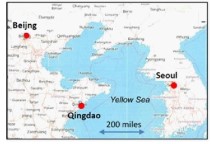
A major city in China’s One Belt One Road (OBOR) Initiative that connects Asia with Europe, it has the highest GDP of any city in the province. Qingdao is a major seaport, has a naval base, and is an industrial center. It has the longest sea bridge (over 17 miles long), linking the main urban areas, straddling the Jiaozhou Bay. The bridge was designed and built by Chinese engineers to survive larger typhoons and earthquakes.

Thanks to German colonization during the 19th century, Qingdao is also famous for Tsingtao beer, and has the second largest brewery in China. With its long coastline along the bay, it has several beautiful beaches and vista points. In 2018, the Shanghai Cooperation Organization held its summit in Qingdao, in a sprawling brand-new building specially built for the meeting. Several heads of states participated. The aquatic portion of the Summer Olympics 2012 was held in Qingdao.
With so many high-visibility events staged in Qingdao, the whole area has received much attention from China’s governments. They have executed massive infrastructure projects against tight schedules.
The prosperity among China’s organized sectors is visible everywhere. In fancy malls, people are in fashionable clothes; they have the latest models of high-end cell phones and European automobiles. They spend their weekends in fancy, mostly Chinese restaurants, and in excellent open-air entertainment centers, . Even with divided 4- and 5-lane city roads, they have traffic jams during peak hours.
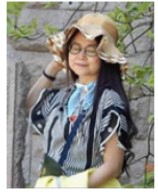
During my stay, on a weekend, my colleague Robin Cao showed me around Qingdao’s waterfront and cityscape, and restaurant scene. It was a pleasant, mild, sunny spring day. Flowers were part of the sidewalks in the city, and not just in any park. You can imagine how many resources the city government spends on beautification!
China has the widest possible choices in food. In one grocery store, different sizes and types of eggs from a variety of birds were on display. You have to see to believe the range of vegetables, grains, noodles, and Chinese buns like our modaks with all kinds of vegetarian and nonvegetarian fillings. And for seafood fanatics and meat-eaters, the choices are endless, with a whole range of fish, crabs, lobsters, turtles, and other reptiles (including snakes); in addition to pork, chicken, beef, lamb, and goat, you also get wild game, and also body parts of large animals such as livers, brains, tongues, etc. A whole range of tropical and subtropical fruits are available, both locally grown, and imported from Malaysia, Thailand, Vietnam, and Indonesia.
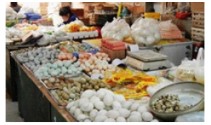
Even as a vegetarian, I had no problem in getting what I wanted in restaurants. When I went with my colleagues, they took care of me. But on several occasions, I explored the restaurant scene all by myself. No one speaks English and they are not embarrassed or apologetic about it. After all, 1.3 billion people speak Mandarin.
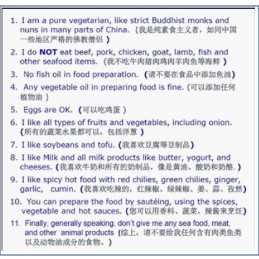
So, language was a big problem for me in exploring the restaurant scene all by myself. I asked my colleague Robin to prepare for me a list of my food restraints written in English and translated into Mandarin. See the figure on the side. In restaurants, the waiter and I would exchange the menu card and my card on food preferences. The waiter would look at it, giggle/smile/chuckle and take me around for me to pick what I wanted from among the items on display. I was never disappointed with what I got.
The many pictures shown here tell you how far China has come. Yes, there is poverty and there are ghettoes. Show me one American or European city that does not have their share of poverty-stricken areas, where working class and poor people live servicing the needs of the affluent.
I had the privilege of having an elaborate 15-course all-vegetarian dinner that my colleague Robin hosted for me in his elegant apartment near the Qingdao University with the mountain range as the backdrop. His wife Jessy, who teaches computer science at the university, was the most gracious host; she told me that in her entire life, this was the first time she had ever made an all-vegetarian luncheon for their guest. Robin and Jessy live with his mother and his 20-year old daughter Anne, who is pursuing her IT degree at Qingdao University.
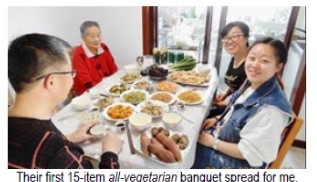
Instead of writing long passages on how the Chinese have adapted to Western influences, the two pictures of women in restaurants shown below can be a metaphor on how China deals with Western influences. I took the pictures in random restaurants where I was having my meals. These women were total strangers to me. (I got their permission for the pictures.) They were elegantly dressed; the woman in the red dress is having her Belgian waffle; and in the other picture, the woman is having a tandoori roti.

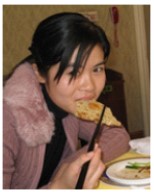
I took the pictures in different restaurants on different days. Waffle is a European breakfast item, and tandoori roti is an Indian item. And without giving up or modifying their lifestyle, and without any embarrassment, they were elegantly using chopsticks to eat food items from all over the world. And there are millions like them all over China.
This goes beyond their eating habits. They are comfortable in being Chinese, even when they become affluent and college-educated. They do not want to change their essential Chineseness. All through the Communist Revolution of the Mao era and the economic boom initiated by Presidents Deng and continued by Xi, the core tenets of Confucian values are still strong. In this regard, the Chinese, Koreans and Japanese are quite different from Indians.
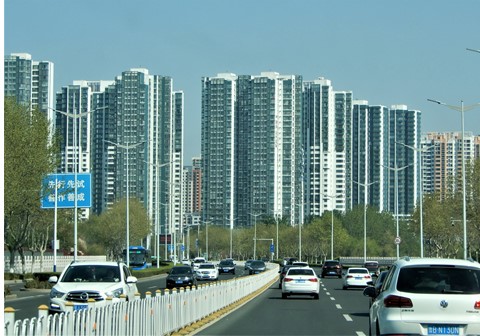
Twenty- and thirty-story high apartment complexes are scattered all over China to meet the ever-increasing demand for the affluent professional middle class. Since no one can own land in China (they can be only taken on 100-year leases), the affluent invest in apartments as a hedge against inflation. This has given rise to a unique situation of having large apartment complexes with only 60% or 70% occupancy. Arab sheikhs, Russian oligarchs, and Indian/Chinese tycoons do the same in London, Paris and New York. Same story with NRIs in urban India.

On the Qingdao bay, the young and affluent Chinese were relaxing in their yachts and speed boats. And in the plaza, a whole bunch of people varying in age from 85 to 2 years and toddlers — great grandparents, sons and daughters and grandkids — were enjoying the sun.


Even on a bright day, some days, the sky was muggy due to pollution. But the government is hell bent on doing its best to reduce the carbon footprint. Public buses and light rail transits are increasingly becoming popular among youngsters.
In China taxis are retired after a certain number of years or after a certain number of kilometers on their odometer. So, taxis are relatively new and clean. All taxis are metered and accept credit cards. I was surprised that in all my rides, the taxi drivers did not wait for my tip, and refused even when I offered, as did waiters in restaurants. This is a huge difference between the US on the one hand, and Europe, China, and Japan on the other. Maybe the money they earn in these occupations given them enough incomes. In the US, waiters in restaurants live only on their tips. In most places in the US, their hourly salary is around $3.00 per hour. Taxi drivers in the US will frown if you don’t tip them.

I was getting ready for my return journey early in the morning. I got into the taxi. The taxi driver turned the ignition key on and pressed a button. A 1-minute audio tape came on asking me one last time: Did you check your passport? Did you check your flight is today? Did you check in already? Do you want to check anything else before we go?
It was a 40-minute taxi ride to the airport. Along the way, the driver wanted to ask me a few details about my flight. He opened an app and said something in Mandarin. The English translation came: Which airline? Domestic or International? Flight number? Departure time? I replied in English and he got the translation in Mandarin. That is how far advanced China is.
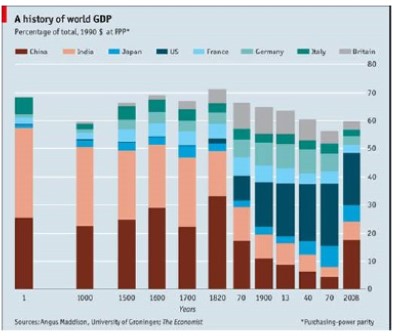
It took China over 70 years to become a vibrant and confident nation to challenge the Western and Japanese domination in the 20th century from the feudal society that it was before Mao’s Revolution. For 1700 years up to the Industrial Revolution, the world GDP of those times was split between India and China. See the adjacent chart. China is fast regaining its past, lost glory. It has become the manufacturing hub for the rest of the world. Its technology base is good and getting better by the day, and its business acumen is something for the rest of the world to worry about. It has developed its own version of the bullet train. It is close to develop a commercial equivalent of the Boeing 737 and Airbus 320 for its own market, which is huge, and later for the Asian market. There is reason for the U.S. and EU to worry. The rest of the world has a lot to learn from China on what to do and how to do it; and, more importantly, how to adapt modern technologies to local conditions. If other nations are smart, perhaps they may even learn how o avoid some of China’s missteps along its path of rapid growth. $$$$
Home:
25th Year and Going Strong!!
Posted by admin in October 2019, Past issues on October 13, 2019
By Kollengode S Venkataraman
The Pittsburgh Patrika enters its 25th year. Reaching this milestone for a financially and editorially independent small-town Ethnic Media publication is noteworthy. Publishing is a time-consuming job requiring attention to detail, working against deadlines from the get-go. Editing, proofing, and laying out in the format, then getting it printed and mailing them for free to 1800-plus addresses every three months takes time.
By choice, we do not seek financial support from any social, political, cultural, religious, or other entity. We pay all our ever-rising bills through our advertisements. Three of our readers on their own send us unsolicited small contributions every year. We owe a big Thank You to all our advertisers and these supporters for their trust in our integrity.
People living among us find time to write articles for the magazine, informing readers about many topics. All the stories in the magazine are about ourselves or on a topic that interests our readers. And deliberately we stay away from the juicy Indian filmi tidbits and also from local gossip. After all, are we all not naked underneath our clothes?
The Pittsburgh Metropolitan Area, with a population of nearly 2.4 million, is the 22nd in the nation. The Indian population in our area is only around 20,000, yet we do have vibrant practitioners of Indian classical and contemporary dances, and vocal and instrumental music, with support from a handful of individual patrons. We can do better with more ticket-buying audiences, given our better education, higher earnings and net worth.
As is the case with all print publications, the Patrika too is facing tremendous headwinds in these days of information overload and other social media choices being available. TV and cell phones have cut into our reading and writing on complex issues. This is a global trend.
In the next several issues, you will see occasional reprints of articles from yester years. In the meanwhile, bouquets and brickbats from readers on the magazine’s 25 years of journey are also most welcome. $$$$
Home:
Affordability of the Retirement Communities in India and in Pune City
Posted by admin in October 2019, Past issues on October 13, 2019
Balwant Dixit, Pittsburgh, PA E-mail: bdixit@pitt.edu
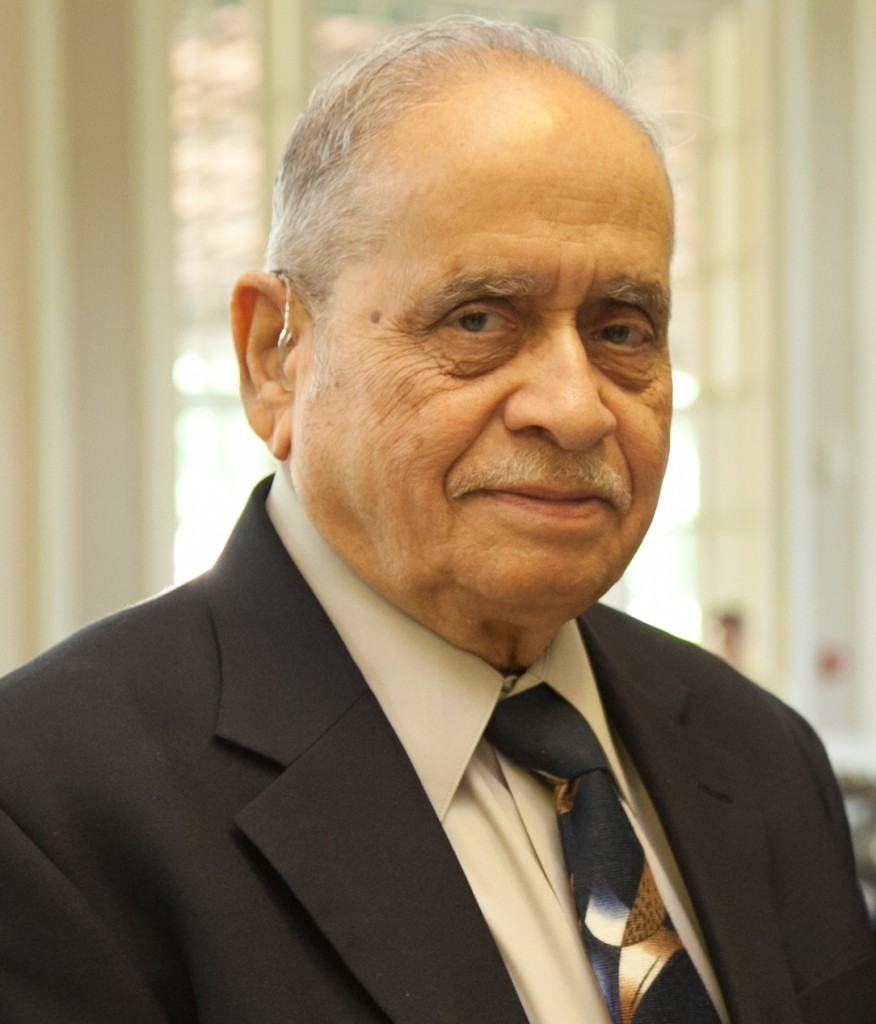
In recent years, many reports describing the beginning of a new era in providing much needed shelter, well prepared meals and affordable basic medical care to an estimated 100 million senior citizens of India have appeared in Indian papers and magazines. Not to be outdone, several Indian publications and organizations in the USA have given glowing reports of the retirement communities established in India. Simultaneously, in the USA efforts are underway to build retirement communities for Indians with great enthusiasm. Such stories in print give Indians living outside India and in India a sense of accomplishment and make them feel confident that the problems senior citizens in India are facing will rapidly be solved by just building a few more retirement communities in India. However, if one looks at the ground reality in India one cannot escape the conclusion that the solutions to the difficulties the 100 million seniors in India are facing today are far from being realistically addressed to.
The majority of India’s current population is less than 30 years old. The traditional joint family system that works in safeguarding the social and economic security of the seniors has been lost. With the emergence of nuclear family, many seniors are exposed to emotional, physical and financial insecurity. In countries like India the magnitude of economic insecurity is very high with more than half of seniors in India are dependents.
According to the 2012 census, the population of India was 1210 million, with a close to 100 million (8.6%) seniors. By 2026 the population of seniors expected to increase to 175 million. Currently, there are 35-40 large independent retirement facilities or communities in India, located in Bangalore, Hyderabad, Dehradun, Chennai, Delhi, Coimbatore, and Pune and in few other cities. The cost of 1BR and 2BR condos in these communities ranges from Rs. 45 lakhs ($50,000) to Rs. 15 crores ($250,000). In addition, monthly service charges range from Rs. 35,000 to 80,000. However, the demand is outstripping the supply by such a wide margin that facilities are sold out before even they are completed. Assisted care, Nursing Care, Alzheimer and Memory Care services are also now available at some of the retirement communities, but costs are very high. Nationally, with the average occupation ranging from 300 to 600 seniors in each of these facilities they can accommodate not more than 15,000 seniors. Usually, the buyers of condos in such facilities are from the top 1% of the Indian population or rich NRIs returning home or some of them buying condos for their old parents living in India. Most of such facilities are located within or near the large urban areas, with relatively easy access to hospitals and large shopping complexes.
Apparently, there is a significant need for these types of relatively high priced facilities in India. For example, a new private, not-for-profit trust, Age Ventures India (AVI), has recently been established to start planning construction of retirement facilities in Bengaluru, Ahmedabad, and Greater Gurgaon area. AVI is partnering with HelpAge India for knowledge sharing and with the USA based Pacifica Senior Living for various aspects of strategic planning. AVI plans to offer comprehensive services necessary for the welfare of the senior citizens
In addition to these large retirement facilities, almost every city in India such as Pune, Mumbai, Delhi, Chennai, Bengaluru, Mysore, Kolkata, Hyderabad have 15 to 20 small retirement facilities offering a mix of amenities such as long or short stay, assisted care, memory care, hospice care with 2 to 4 beds in each room. The quality of bedroom furnishings and associated furnishings vary significantly from one to the other. Meals are usually provided and the monthly service fee ranges from Rs. 40,000 to 70,000 and some facilities even charging up to Rs. 50,000 to get on the waiting list. Such small facilities are always located within the city limits for easy access to medical care and other amenities. These small size facilities can accommodate an additional estimated 6000 seniors.
HelpAge India is a leading charitable organization working with and for seniors and older people in India for the past 40 years. It runs a gamut of programs with the aim to serve needs of elders in a holistic manner, enabling them to live active, dignified and healthier lives. HelpAge India has established 26 old age homes for the seniors in places such as Patiala, Tamil Nadu, Mumbai, and Kolkata accommodating estimated 2,000 seniors and old age persons. Their facilities can provide comprehensive support to their inhabitants at a relatively low costs since HelpAge operates principally on donations they receive from individual donors, corporations and Trusts & Foundations.
All these facilities collectively can accommodate a total estimated 30,000 seniors, i.e. about 0.003% of the total senior population, leaving 99% of the seniors in need of affordable retirement facilities. How that can be done is a big question that defies easy answers since verifiable data on the needs of seniors is not available.
There are several hurdles in the planning of future facilities in India. No oversight agencies or regulations to monitor the financial stability of the retirement communities. Nearly a total lack of reliable data about the living and economic conditions, social profile, and assistance available for the activities of daily living (ADLs), the primary caregiver and the health and nutrition across the population of seniors. There is no standardization of services and costs associated with them. The Indian population is divided into rural (65-70%) and the urban (35-30%). Only scant data are available is on a small sample of the urban population. The value system and family dynamics is different in many respects when one compares the rural and urban population of seniors.
The relevant questions that need to be answered are: How many of the estimated 100 million seniors can afford to move away from their current place of residence and live away from their relatives to live independently? How many can afford to pay for their health care?
In India there are laws that allow the parents to sue their sons and daughters who refuse to provide financial support to them. In cities like Delhi, Mumbai and Pune there are examples of aged parents suing and winning cases against their children for kicking them out. In some of the metropolitan areas and in rural communities there are cases of sons or daughters dropping or abandoning their elderly mothers where they are given help by NGOs and Mandirs for survival.
In 2016 the Tata Institute of Social Research completed a survey, “The Situational Analysis of Elderly in Pune City†about the seniors in Pune City on the conditions senior citizens are living and the difficulties they are experiencing on a day to day basis. The survey evaluated (i) Living conditions (ii) Economic conditions (iii) Social profile (iv) Activities of daily living (ADLs) and instrumental activities of daily living (v) Primary caregiver (vi) Health and nutrition.
This type of study is a rare in India, while a lot of credible studies related to the problems faced by seniors have been conducted in the West. The Pune City was selected because it is one of the fast growing cities in India and has been touted as the retirement capital of India. In 2016, the population of Pune was 6 million, with seniors estimated at 500,000 (8.5%); greater than 30% of them living in slums.
Currently there are four (55+) independent living retirement facilities (Athashris) and an estimated 20 small Continuing Care Retirement Community (CCRC) type facilities in Pune. The cost for a one BR condo is about Rs. 45-60 lakhs in Athashris. Monthly service cost in a CCRC type of facilities varies from Rs. 35,000 to 45,000. All these facilities together can provide housing for only about 2000 seniors i.e. for 0.005% of the estimated population of seniors in Pune.
The main conclusion of the survey indicates a very difficult situation being faced by seniors in Pune, with the conclusion that these types of facilities are unaffordable for the 99% of the seniors in Pune. To make the situation worse politicians of every political persuasion announce before the election that they intend to build retirement facilities in every town and villages in India if elected, and after getting elected, they comfortably forger there promises. $$$$
Home:
Dekho Hamara Hindustan — Story of A Missing Elephant
Posted by admin in October 2019, Past issues on October 13, 2019
Premlata V
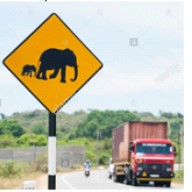
This could happen only in Hamara Hindustan. An elephant went missing, not in one of the Kerala-Karnataka Temples where elephants are part of the temple retinue. And not in their natural habitat in the Western Ghats in Tamil Nadu, Kerala and Karnataka, where road signs display elephant corridors warning motorists of herds of wild elephants crossing — like deer crossing signs here. Remember, these winding roads in India go through the natural forest habitat of the elephants. So, on these roads elephants have the right of way over motorists for road crossings. See the picture below.
But this elephant went missing in July this year in — hold your breath — of all the places, metropolitan New Delhi with a bulging population of over 18 million people. And Laxmin, the elephant, was the only one in the entire Delhi Metro area at that time.
According to the story in the Indian Express (September 17, 2019), the missing elephant Laxmi kept the Delhi Police and wildlife officials on its tail since July, with a nationwide alert being sounded. The 35-year old pachyderm was last seen along the banks of the Yamuna. But Laxmi was kept right in New Delhi all the while by her mahout Yusuf Ali.
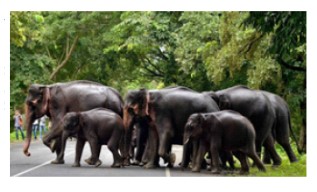
The relationship between elephants and its owners and mahout is symbiotic. Often, elephants outlive their mahouts and when the mahouts die, elephants weep in grief and refuse food for days.
Delhi’s wild life officials said in early January, Laxmi and five other elephants in Delhi were kept in “poor housing and health conditions and lack of suitable space and water facilities in Delhi, violating the 2008 guidelines by the Union Environment Ministry.â€
One wonders why these “wild life†officials don’t recognize the wild species of Homo sapiens in Delhi living in fancy high-rise apartments living their “wild lives†with impunity.
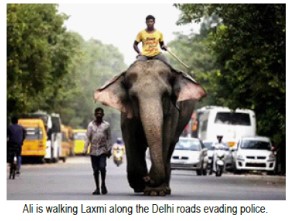
In mid-September, The Indian Express staff met the elephant’s owner Yusuf Ali (45), who was with Laxmi in Delhi. Evading arrest, Ali said he and Laxmi never left the capital. Initially, he “hid†Laxmi in a wooded area along the Yamuna.
One of Ali’s friends then told Ali he had a large farmhouse where he could keep Laxmi. And that is where she had been ever since she went “missing.†Ali took her out every evening for a walk for about an hour or two. Ali would occasionally step out of hiding to buy food for Laxmi and to meet his family. Even when he didn’t have enough to eat, he took care of Laxmi. He would arrange a 500-litre water tanker every day along with sugarcane and jowar.
Mr. Ali now has a non-bailable warrant against him under IPC sections 353 (assault or criminal force to deter public servant from discharge of his duty) and 186 (obstructing public servant in dis-charge of public functions). Ali says he will abide by the court’s decision. “This is my elephant, and I have an emotional attachment with it.†$$$$
Home:
Uncertainty for the Near Future in South Asia
Posted by admin in October 2019, Past issues on October 13, 2019
By Kollengode S Venkataraman
All abrupt changes need time for adjusting to new realities. With India making J&K a Union Territory, the Line of Control is now the de facto International Border. The on-again-off-again India-Pakistan diplomatic relationship will be off-again for the foreseeable future.
For starters, there will be only minimum diplomatic contacts between India and Pakistan. The already dormant South Asian Association for Regional Cooperation (SAARC) is now dead, buried in Pakistan and cremated in India. Pakistan has banned direct trade with India, even though it benefits its economy and its working poor, given the economic crisis Pakistan is experiencing. People-to-people contact are gone. It may close its space for airlines for all flights to and from India.
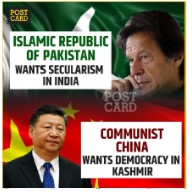
In his tweets, speeches, interviews and writings, Imran Khan repeatedly throws incendiary terms like fascist, racist, Nazi, Hitler, Mussolini, ethnic cleansing, Hindu Supremacists and Muslim persecution, when referring to Modi and his government. This he does to whip up anti-India, anti-Hindu feelings in Pakistan and draw the Western media’s sympathy.
Pakistan, given its severe economic crunch, cannot afford a full-scale conventional war stretching even a few weeks. So, border skirmishes will be the norm, with frequent terrorist attacks in J&K and elsewhere in India. The two countries spying on each other will intensify. Military and security outlays will increase further, possibly hurting Pakistan more.
Given the severe strains in Pakistan’s economy and its aam-aadmi problems, its faujis will not be interested in a coup. The current arrangement of having a pliable, weak prime minister allows it to let the elected nominal government face all problems, while appearing to keep its hands clean.
If Pakistan’s military thinks it has nothing to lose — or the loss it will inflict on India will far more severe — nothing will stop it from initiating skirmishes in Kashmir that could escalate into war. In desperation, Pakistan’s military may even consider the nuclear option. Imran Khan repeatedly warns the world of this possibility, trying to force the global powers to intervene. But even an adventurous and foolhardy military will count its beans before getting into a mess much bigger than what it can handle.
For India too, conventional war with Pakistan will impede its efforts to leap forward from new projects critical for its growth to catch up with China on many fronts. But if Pakistan attacks India again as it did in the Indian Parliament in 2001 and in Mumbai in 2008, India will be forced to respond.
The several invectives that Imran Khan raised against Modi on the abrogation — like changing the demographics of Kashmir, ethnic cleansing, ill-treating minorities and others — are more applicable to Pakistan. The Hindu population in Pakistan in 1971 (after the Bangladesh war) was nearly 2.9%. Now it is around 1.7%. Pakistan’s Hindus, Christians, Ahmedis, and Sikhs complain about violence against them and their women. Balochs complain that Pakistan’s Punjabis and Sindhis are changing the demographics of Baluchistan, the mineral rich, thinly populated region. Christians, Sikhs and Hindus are prohibited by law from holding the office of president, prime minister, or chief Justice, or in the military. Ahmedis are hounded out and persecuted, and cannot even contest elections. And Pakistan has already changed the demographics in the part of Kashmir it occupies and in the Gilgit/Baltistan region with people from the Punjab. Pakistan-occupied Kashmir is now directly administered by Islamabad. So, on these matters, Imran Khan has to only stand in front a mirror before accusing Modi.
The real winner are the Ladakhis. People in Jammu have welcomed the abrogation. The Ladakhis, now in a directly administered Federal Region after the abrogation, are ecstatic since they will be no longer exploited by Kashmiris in Srinagar and in the Valley. While the Muslims in the Valley in J&K complain about New Delhi’s domination, they have been dishing out the same thing to Hindus in Jammu and to Buddhists in Ladakh. The Ladakh region has been exploited and neglected since 1947 in every way possible by the Kashmiri Muslim political leaders.
This article would be incomplete without presenting the plight of the Kashmiri Hindu Pandits, who are part of the larger Saraswat Brahmin community. The Kashmiri Pandits’ contribution to Indian intellectual life has been enormous through the millennia. Here are some of the big names: Charaka (300 BC, the father of Ayurveda); Vishnu Sharman, the author of Panchatantra (300 BC); Nagasena (200 BC) Buddhist Scholar; the famous Kalidasa (5th century AD); Somananda, the famous teacher of Kashmir Saivism (9th century); the polymath Abhinavagupta (10th century); Utpala, a mathematician (10th century); Kalhana, poet and dramatist known for Rajatarangini (12th century); Sarngadeva, the musicologist (13th century AD); and the list goes on.
In the 1980s, over 450,000 Pandits were in the Kashmir Valley, having lived there for millennia. The Jammu-Kashmir Liberation Front run by Muslim separatists, securing money and arms from Pakistan and other sources, targeted the Pandits and their women with gruesome violence and threats of violence and drove them out of the Valley. Now, hardly 3000 Pandits live there. Their exodus from the valley is hardly highlighted as ethnic cleansing, even in the Indian media.
[Many Kashmir Pandits converted to Islam over several centuries, and are now prominent political leaders. Kashmiri Muslims carrying the same DNA as the Hindu Pandits are responsible for the ethnic cleansing of the Hindu Pandits. That should send a chill through anyone’s spine.]
In the next few years, if the Modi government proves that it is serious about delivering all things to the people of Jammu & Kashmir and Ladakh that the abrogation of the articles promises, there is a good chance that after some hiccups and initial difficulties, ordinary Kashmiris in the valley will see their own self-interest and accept the abrogation. This will weaken the hands of the militants and the Hurryat separatists asking the Kashmiri youth to indulge in violence, thus jeopardizing their future. It is unconscionable that the Hurryat leaders live in relative comfort in Kashmir, and their sons and daughters live in and outside India leading placid, secure lives as doctors, engineers and professors. Kashmir deserves a respite from the corrupt Abdullahs, Muftis, Gandhi satraps, Hurryat leaders, and the violence let loose by the separatists and the terrorist outfits with Pakistan support. $$$$
Home:
Chinmayananda’s Mahasamadhi Day Celebrated with Reverence
Posted by admin in October 2019, Past issues on October 13, 2019
By Ganesh Krishnamurthy, Volunteer Chinmaya Mission Pittsburgh
Chinmaya Mission Pittsburgh (CMP) hosted its first Chinmaya Mahasamadhi Camp from July 29th to Aug 4th at the Doubletree Hotel in Greentree. The camp is an annual week-long family spiritual retreat for people active in the Chinmaya Mission, and is also open to the public, hosted by different centers in North America. San Diego and Chicago hosted the last 2 camps.
The camp’s thrust is to celebrate the life of Swami Chinmayananda, a great exponent of the Hindu Vedantic teachings in the 20th century. Swami Chinmayananda left this world on August 3, 1993 in San Diego and the annual camp culminates on Aug 3, with a devotion filled Mahasamadhi puja.
The main topic for this year was Krishna Leela and was presided over by Pujya Swami Swaroopananda of the Chinmaya Mission. The attendees also heard discourses by Swami Shantananda on Chapter 8 of the Bhagavad Gita and Swami Prakashananda on Purajana Gita.
The organizing team of volunteers endeavored to make the campers like the members in Gokul and Vrindavan with exhibits and murals of child Krishna.
To help complement Swami Swaroopananda’s discourses, several well-known episodes of Lord Krishna’s stories — like Krishna’s birth, Kaliya Mardhanam, and Raasa Leela — were brought to life through dance recitals staged by members of Chinmaya Mission. Abhang recitations, and painting jugalbandi were other attractions.
On August 3, all participants offered a Mahasamadhi Puja showing their veneration to Swami Chinmayananda. A highlight of the day was the traditional Kerala-style authentic meal on banana leaf in remembrance of Gurudev who was from Kerala. A separate exhibition showcased pictures, quotes and audio clips of Gurudev.
Many guests associated with Chinmaya Mission for a long time were thoroughly impressed with how the retreat was organized and said this was the “best they have gone to.†Guests also visited the Sanjeevani ashram and the SV Temple on one of the afternoons. Guests were amazed that Pittsburgh, in spite of being a smaller city, had places of worship, spiritual centers and a thriving cultural network, supported by a warm and well-connected Indian community.
Pittsburgh has a special connection to Gurudev since he came to Pittsburgh in the 70’s. He said Pittsburgh’s confluence point of the three rivers reminded him of the Triveni Sangam in Prayaag. For members of the Pittsburgh branch of the Chinmaya Mission who had met and interacted with Gurudev, it was a special and emotional moment to host the camp in Pittsburgh. The members of the Chinmaya Mission of Pittsburgh acknowledge with gratitude the support and help they received from members of our community in various ways for making the retreat a memorable one. $$$$
Home:
Prthvi ka Swarg Pittsburgh — A Poem in Hindi
Posted by admin in October 2019, Past issues on October 13, 2019
By Acharya Jagdish Chandra Joshi
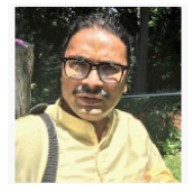
Acharya Jagdish Chandra Joshi was born in the Indian state of Uttarkhand at the foot hills of the Himalayas. His high school education was at Haridwar. His father, Joshi says, never pushed him into any field, but insisted that he does well in the field he chooses. So modern!! His family was steeped in Sanskrit linguistic traditions. So, he was naturally towards Sanskrit classics. After topping his class in high school, when Joshi went to Varanashi, he was the first in his family, may be in his entire village, to go to the place for higher education in Sanskrit. He earned his master’s degree in Sanskrit literature. He also learned vocal and instrumental music there, along with Vedic literature. Working as a Pandit at the Hindu-Jain temple since 1999, Joshi has traveled all over the U.S. for conducting various services for Hindus.
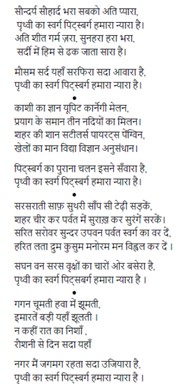
$$$$$
Home:
The Jammu-Kashmir-Ladakh Conundrum Straightened Out and Yet Not
Posted by admin in October 2019, Past issues on October 13, 2019
By Kollengode S Venkataraman
The complex history of Kashmir from all perspectives is scattered throughout cyberspace. Atul Singh and Manu Sharma’s recent summary What Lies Behind India’s Bold Bet on Kashmir? in the on-line magazine Fair Observer is an example.
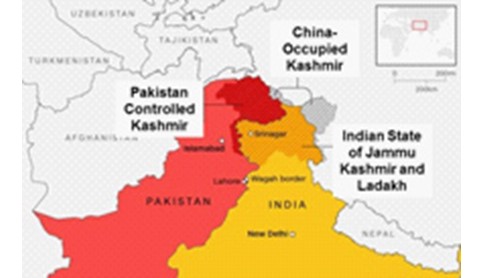
Pakistan does not even recognize Articles 370 and 35A of the Indian constitution, which, in 1954, gave special status as a temporary measure to India’s Jammu & Kashmir (J&K) state after its accession in the 1947 Partition. In 1947, when Kashmir’s king Hari Singh joined with India, Pakistan sent its forces and took control of part of Kashmir. The maps below show how Kashmir is split among India, Pakistan, and China, with the former two claiming the whole of Kashmir. The Line of Control (LoC) is the current de facto border.
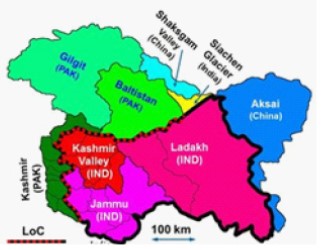
To begin with, the two articles in the Indian constitution, included as temporary measures, are discriminatory Women face disparities in property and marriage rights vis-a-vis men. There is no constitutional protection for the Scheduled Castes and Scheduled Tribes and minorities. Indians are prohibited from a) claiming residency in the state no matter how long they have lived there, b) acquiring property, c) getting assistance from government programs, and d) securing government jobs and scholarships for children in colleges.
These factors and the continual violence, particularly in the Kashmir Valley, has not helped in developing the region in the last thirty years, compared to the rest of India. But as happens with any government, once you put any rule to suit the need of the hour, vested interests take over, making it impossible to change them.

In the meantime, Kashmiris have spread out all over India establishing themselves, buying properties, running businesses, educating their children, and getting all the other benefits of the Indian citizenship.
The Kashmir issue is the “jugular vein†for its military and its politicians. So, Pakistan tries to “internationalize†India’s August 5 abrogation of Articles 370 and 35A, even though it does not even recognize them. Pakistan’s military has perpetuated its iron grip on Pakistan’s government and resources, penetrating Pakistani society through the thousands of businesses the military runs. So, India as an eternal threat is necessary for the military to continue its hold on Pakistan’s civil society.
In the politics of the J&K state since 1947, only a few families have had influence and control: the Abdullahs (Sheikh, his son Farookh, and Farookh’s son Omar); the Muftis (Mohammed Sayeed Mufti and his daughter Mehbooba); the Lones and the Ansaris; and finally, the Nehru/Gandhi family’s satraps. Corruption in public life in any system with only a handful of families having power for generations needs no explanation. This is endemic throughout India.

Given the pre-British bloody history of the region and how India and Pakistan violently sliced the region between themselves during Partition, it is impossible to mediate an acceptable solution. On Kashmir, there are more than two parties — the governments of India and Pakistan, Pakistan’s military, hardliners in each country, Kashmiri separatists, and then, China. So, the ulcerous issue has festered for over 70 years.
The British colonial occupiers left India in reckless haste in 1947, letting the “native coolies†fend for themselves and sort out the issues. If they thought that the ensuing confusion and violence would keep their influence and control on the natives, they were mistaken. Over the past 70-plus years, all options have been tried to resolve the issue:
a) Pakistan-initiated outright wars in 1965, 1971 and 1999; continual stealth operations by Pakistan across the LoC and in the Kashmir valley through the decades; and providing “political, moral, and diplomatic†support (which means providing arms, money and intel) for the Kashmiri separatists and terrorists; b) hyped up summitry between the India-Pakistan heads of governments, secret back channel contacts between government-approved interlocutors; c) soft power people-to-people contacts, sports and cultural exchanges, and train and bus services across the border; d) improving trade that will obviate the very idea of “borders†in the globalized world; e) nuclearization of the region with tens of atom bombs by India and Pakistan (and China) with sophisticated delivery systems with historically ominous names (Pakistan’s Ghauri, Gaznavi, Abdali, and Babur missiles). But nothing has worked.
President Trump’s unsolicited, gratuitous mediation offer was the tipping point. In diplomacy, Trump is as nuanced as a wild raging bull in a china shop. So, nobody took seriously the unsolicited mediation offer — not to mention the arbitration offer — he flippantly and irresponsibly threw at TV reporters when Pakistan’s Prime Minister Imran Khan visited the White House last July. The unsolicited offer Trump made was lapped up by Pakistan as a game changer in this intractable issue. In a way, it indeed was, but not in the way Pakistan wanted. India never wasted time in saying publicly “Thanks Mr. Trump, but no thanks.†Later, with Trump at his side at the G-7 meeting in France in August, Modi declared that all India-Pakistan issues “are bilateral†and will be resolved bilaterally.
In India all political parties, in principle, have committed to scrap the Articles, which were, after all, temporary measures. The Congress Party has been whittling down their provisions over the years. For the Bharatiya Janata Party (BJP), scrapping the articles was a public declaration. The BJP returned to power in the May 2019 elections with even a greater majority than what it got in 2014. In public discourse, this has been debated ad nauseam. Besides, as reported by TCA Sharad Raghavan in The Hindu, (July 24, 2016),
“Jammu and Kashmir [alone] has received 10 per cent of all Central grants given to states [during] 2000-2016, despite having only one per cent of the country’s population… … In contrast, Uttar Pradesh [with] about 13 per cent of the country’s population received only 8.2 per cent of Central grants in 2000-16. That means J&K, with a population of 12.55 million according to the 2011 Census, received Rs.91,300 per person over the last sixteen years while Uttar Pradesh only received Rs.4,300 per person over the same periodâ€
The Modi government saw the atmosphere was ripe (see the article below) for scrapping J&K’s temporary special status. So, on August 5, it moved resolutions in both houses of the parliament scrapping the two 70-year old articles from the Indian constitution. In doing so, it incorporated Jammu and Kashmir as a federally administered area with its own elected legislative body; and the Ladakh/Kargil region, to be directly administered by the Federal government in Delhi. n
The Timing of the Decision
In politics, timing is everything for bringing about far reaching, fundamental changes. Just consider these factors the Modi government would have considered before scrapping Articles 370 and 35A.
1. For the second time, the BJP returned to power in the May 2019 national elections with an even greater majority and approval. It is unlikely that this will be repeated again in the next general election in 2024. The fragmented Indian opposition parties are in disarray. The Congress Party has lost its moorings — even its relevance — in Indian politics with its sycophantic senile leaders genuflecting in front of the inept Gandhis. In the parliament, no party even qualifies as the official Opposition party.
2. Pakistan has problems on multiple fronts. Imran Khan is a weak prime minister without a majority in the parliament, picked for the job by Pakistan’s powerful military. In fifteen months in power, he has put key opposition leaders in jail. The Human Development Index (taking into account literacy, access to health care, gender equality, living standards and other measures) of Pakistan is poor, 150th among 189 nations. India’s is only slightly better, at 130/189. Pakistan has accumulated massive debt. In the last 25 years, it has gone to the IMF 13 times (including in 2019) for bailouts. Each time the loan was given under tighter conditions. The Pakistani rupee has lost 30% of its value in the last 12 months; its stock market has taken a similar beating. Srging inflation and unemployment are hurting the working poor. Pakistan’s influence in the Muslim Ummah, even with its nuclear weapons, is not where it wants to be vis-a-vis India’s. There is resentment among the Balochs over exploitation and neglect. Sindh has its own simmering problems with Punjab and with Mohajirs (the Urdu-speaking descendants of Muslims who moved from India to Pakistan in 1947).
3. As mentioned earlier, politicians, diplomats, back channel folks and outside interlocutors are not able to resolve the issue. Pakistan-initiated wars, infiltration and the arming of separatists — even the nuclear weapons with missiles — have had the same effect.
4. Major global powers have their own issues – Russia with Crimea; China in Tibet, Hong Kong, and in handling the Muslims Uighurs; the US with Mexico and illegal immigrants. Besides, Iraqis and Syrians and others from Muslim nations are seeking political/economic asylum in Europe, US/Canada, while other rich Arab nations (Saudi Arabia, the Persian Gulf countries, Kuwait) are simply standing by.
5. The world is weary of the Kashmir issue that has been festering for over 70 years. In the UN General Assembly’s annual fall jamboree, every time India and Pakistan talked on Kashmir, the delegates yawned. These addresses were only for local consumption in India and Pakistan.
6. The EU is in its own mess with Brexit. The United Kingdom in today’s world is irrelevant. The Empire imploded decades ago.
7. The world economy is faltering after 12 years of expansion. With Trump’s tariff wars on the rest of the world, free trade is now dead with far-reaching implications. So, Kashmir is peripheral to many leaders.
8. India has a better technology base. The goodwill capital of millions of Indians working in many countries as engineers, doctors, teachers, carpenters, electricians, construction workers and taxi drivers is getting transferred to India. But the Indian economy — and the global economy as well — has been faltering lately.
With the erratic Trump, the Sole-Super-Power U.S. has no gravitas on the world stage. Trump is now a caricature.Trump’s gratuitous unsolicited mediation/arbitration offer was the proverbial Indian crow landing with a jerk on a bough of a tree with a fully ripened fruit ready to fall at any moment. Trump’s gratuitous offer was the jerk.
Thus, tactically, the time could not have been better for the Modi government to take a deep breath and scrap Articles 370 and 35-A in one stroke through legislation. And it did so on August 5, 2019 with a better than 2/3 majority in both houses of the parliament, despite the BJP not even having a majority in the Rajya Sabha (the Upper House). The Supreme Court will remember this when the case reaches its doors. $$$$
Home:
Ha!! On Predictions by Experts
Posted by admin in July 2019, Past issues on July 2, 2019
In the absence of our own understanding of the science and technology behind many inventions, we look for experts in the field to project the shape of things to come in the field of their expertise in the implicit assumption that they have better insights into the future looking through their special crystal balls. How innocent we are in our assumption and belief and how wrong these experts have been!. Here is a list culled from diverse sources:
“Rail travel at high speed is not possible because passengers, unable to breath would die of asphyxia.â€Â — Dr. Dionysius Larder Professor of Natural Philosophy, University college of London (1783-1859)
“Heavier-than-air flying machines are impossible.†— Lord Kelvin, British mathematician and physicist, president of the British Royal Society, 1895. The absolute temperature scale (0 Celsius = 273 Kelvin) is named in his honor!.
‘The horse is here to stay, but the automobile is only a novelty — a fad.â€Â  — The president of the Michigan Savings Bank advising Henry Ford’s lawyer to not invest in the Ford Motor Company (1903)
“The cinema is little more than a fad. It’s canned drama. What audiences really want to see is flesh and blood on the stage.†— Charlie Chaplin (20th century.)
“Who the hell wants to hear actors talk?â€â€™ — H.M. Warner co-founder of Warner Brothers
“There is no reason for any individual to have a computer in his home.†— Ken Olson, chairman and founder of Digital Equipment Corporation.
“With over fifteen types of foreign cars already on sale here, the Japanese auto industry isn’t likely to carve out a big share of the market for itself.†— Business Week, 1968.
“640kB should be enough for anyone.†— Bill Gates, 1981
“The world potential market for copying machines is 5,000, at most,†— IBM to Xerox in 1959.
“The concept is interesting and well-formed, but in order to earn better than a ‘C’, the idea must be feasible.†— Yale professor to the founder of FedEx Fred Smith when he was a MBA student. ♠
Home:
High-Protein Low-Carb Idlies
Posted by admin in July 2019, Past issues on July 2, 2019
By K S Venkataraman ThePatrika@aol.com
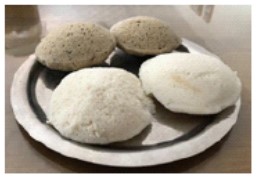
Indian dals contain proteins between 15% and 25%. Protein-rich dals have low glycemic indexes compared to white rice. The proteins in individual dals, made up of amino acids as building blocks, do not contain all the nine essential amino acids (histidine, isoleucine, leucine, lysine, etc.) our body needs. Hence vegetarians need a combination of several dals plus seeds/nuts, tofu, and milk products to get complete proteins.
I. Ingredients:
In the list below, broken lentils with the husk/skin intact are given because they soak quicker. Unbroken lentils are a better choice, but they need longer soaking times. The husk/skin is a good source of fiber.
1. Chana dal: 1 measure (use any volume measure)
2. Toor dal: 1 measure
3. Broken sabut Urad with the husk/skin intact): 1 measure
4. Broken sabut moong with husk: 1/2 measure
5. Broken Red Mung Beans: 1/2 measure
6. Boiled rice (this is not parboiled rice and not cooked rice): 2 measures. Note: This is a unique South Indian rice available in Indian stores. One brand is Ponni Puzhungal Arisi (Boiled Rice).
7. Options: Red chillies, cumin seeds, black pepper, ginger, to taste
Note: In the above, rice is only ~33% of the total. In white idly batter, rice content is between 60% – 80%. This alone reduces the glycemic load in this recipe.

II. Soaking: In lukewarm water soak all in one vessel for at least 4 hours if you use broken dals. Unbroken lentils take a longer soaking time. Wash the soaked grains in water.
III. Making the Idly Batter: Go to YouTube to see the consistency of the idly batter and for idly making techniques. The common run-of-the-mill kitchen blender is a bad choice for wet grinding since it gets quite warm heating up the batter. The rugged high-wattage Vita Mix blender may work. Traditional Indian wet grinders are the best.
Wet-grind the soaked grains until the batter is very smooth. If there is too much water, the batter becomes too thin, and is not good for making idlies. Transfer the batter into a large vessel. Add salt to taste and mix it well. If you added too much water during grinding, you can still salvage the batter for making dosai-equivalent. ;–)))
IV. Fermenting the batter: This is critical. Keep the wet-ground batter at temperatures between 70 F to 80 F for at least 8 hours for it to ferment. The batter, when fermented, will rise in the container with tiny air bubbles filling the space. That is why you need a large vessel.
V. Making the idlies: If the fermented batter is too thick, add a small quantity of water and gently mix the batter using a spatula. Do not beat the batter too much. This drives away all the air bubbles. The trapped tiny air bubbles make the idlies spongy.
Pour the batter on the idly-making plate and steam-cook it — NO pressure cooking — for 10 minutes minimum. Take out the idly plates from the steamer and cool. Scoop out the idlies from the idly plate.
In the picture shown on the top, the regular idlies are in the front and the high-protein idlies are in the back. The high-protein idlies are darker because of the dals and the husk/skin in the batter. Eat these idlies with Molagai Podi (known as gun powder in north India) or chutneys. ♠
Home:
Pazhaya Paadal, Puthiya Aadal ! Brings Old Film Songs to Bharatanatyam Stage
Posted by admin in July 2019, Past issues on July 2, 2019
By G. (Paul)Â Manoharan, Upper St Claire, PA gopalsamy.manoharan@stifel.com
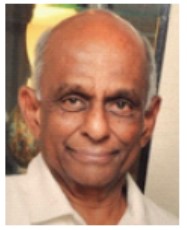
Editor’s Note: For a variety of reasons, Indian classical dance teachers have been reluctant to choose songs for their recitals from the large collection of classy film songs rooted in pure Indian classical dance traditions. Jaya Mani, our veteran dance teacher, breaks this unwritten taboo by staging a program entirely taken from films songs.
On Saturday, May 18th, 2019 at the Sri Venkateswara Temple auditorium, twelve senior students of our veteran Bharatanatyam teacher Jaya Mani presented a unique and enjoyable Indian classical dance program titled in Tamil “Pazhaya Paadal Puthiya Aadal “ (Old Songs & Modern Danceâ€). The songs were from movies dating back to 1948 through 1988 from Tamil movies such as Vedhala Ulagam (1948); Manamagal (1951); Vanjikottai Vaaliban (1958); School Master (1958, Telugu); and Katputli (1957, Hindi). Jaya Mani and her students choreographed the pieces, sometimes independently and sometimes jointly.
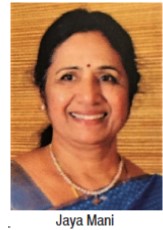
With Deepa, Jaya Mani’s daughter, co-directing, Subha Sriram emceed the program introducing each piece giving the filmi tidbits for each song, such as the lyricist, music director, playback singers, and actors. This kept the audience engaged.
Details of these songs have faded away even for old timers. Many youngsters were probably listening to these songs for the first time. But the lyrics for the songs by great poets (Subramanya Bharathi, Papanasam Sivan, Kannadasan, Udumalai Narayana Kavi and others), the music direction by masters (K.V.Mahadevan, G. Ramanathan, Sankar-Jaikishan…), and the enchanting voices of M.S.Subbulakshmi, M.L.Vasantha Kumari, P. Leela, and Lata Mangeshkar are enshrined in our hearts forever.
Jaya Mani and her students took us back to the golden era of Indian movie classic songs, creatively choreographing the songs to the idioms of the Indian classical dance traditions, adding jatis and abhinayams making them lively and enjoyable.
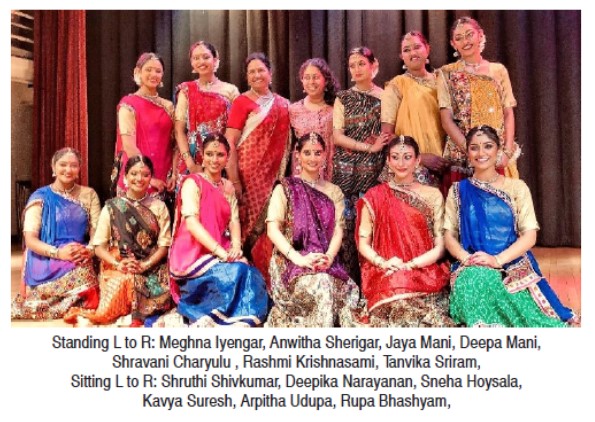
Songs such as Theeratha Vilayattuppillai and Kuravanji dances have been part of the Bharatanatyam repertoire for decades, but dances to songs such as Ellam inbamayam (Deepika Narayanan and Kavya Suresh, Rupa Bashyam and Tanvika Sriram) and Kannum kannum kalandu (Shravani Charyulu and Arpitha Udupa) were real treats.
Jaya and the artistes’ maiden attempt to bring the best of old and new together was enjoyable and made us wish for the good old days when we could sing along, unlike the contemporary movie songs dominated by beats and rhythm with the orchestra overwhelming the human voice.
All the songs used straight film clips running only 3 or 4 minutes, which is necessitated by the time constraints of films. However, there is enough scope in these songs to re-record them by adding more jatis and swarams to expand them as stand-alone 6-to 8-minute pieces as in padams in Bharatanatyam recitals. ♠
Home:
Obituary: V. Udaya Shankar Rao — 1938 to March 26, 2019Â Â Â Â Â Â Â Â Â Â Â Â Â Â
Posted by admin in July 2019, Past issues on July 2, 2019
By K. S. V. L Narasimhan, Moorestown, NJ sim.narasimhan@outlook.com
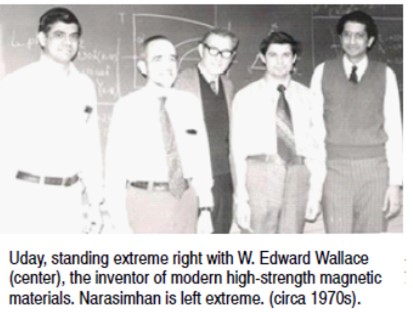
Vallabhajosyula Udaya Shankar Rao, known simply as Uday to his friends, passed away on March 26, 2019 after stoically living through Parkinson’s disease for the last few years. He was 80. He was born on August 4, 1938 in Vijayanagaram, a small town along the Coastal Andhra Pradesh north of Vishakhapatnam. With his mother passing away when he was young, he and his two young-er sisters were raised by their aunt Aadilakshmi, and her husband Voruganti Lakshmikantham.
After obtaining a bachelor’s degree with honors from Andhra University (1958), Uday joined TIFR and earned a PhD in physics from the University of Bombay (1967). In Mumbai, when he was hospitalized briefly, he met his future wife, Cecilia, an attending nurse at the hospital. After their marriage in 1966, they came to the United States in 1968 with Uday’s postdoctoral fellowship at the University of Pittsburgh, where he later became an assistant professor. Uday was highly respected among the post-doctoral fellows .His ability to break down complex tasks to manageable simple steps helped un-ravel the mystery of why rare-earth magnets are so powerful,
After a short stint at U.S. Steel, he joined the Department of En-ergy’s Pittsburgh Energy Technology Center, working on catalysts for converting coal to liquid fuels. In 1989 he received an award for his work from the Pittsburgh-Cleveland Catalysis Society. He retired in 2006.
During the early days of Sri Venkateswara temple, Uday was active with many of us in assisting Raj Gopal in building the temple for Sri Venkateswara. Originally the temple was to be built in Monroeville, where the Hindu-Jain temple is today.
Conflict on the details of the temple resulted in us breaking away to the current location in Penn Hills. The separation of the Indian group was painful, with Uday, myself, and many others pleading for unity in a meeting where tempers were flying high. With no place even to meet, Uday helped us get together in a classroom at the Uni-versity of Pittsburgh where the first draft of the letter for the S V Temple was prepared for mailing to potential donors. Uday was part of the working committee, executive committee and later served as Chairman of the board of trustees.
Uday always wanted to help the needy. In one of our board meetings he wanted the temple to assist a student at Penn State who was wrongfully convicted. He proposed sending $30,000 to assist in paying the legal fees. The board started debating on the amount rather than on the role of temple in these situations. Finally, an amount was sent. The construction of the temple consumed most of our lives from 1973 for several years.
Uday was a great enthusiast of Indian classical performing arts. He himself would go on stage and sing on the Aradhana Days at the temple.
When I moved from Austin, Texas to Pittsburgh to work at the University, Uday and Cecilia took care of me to settle down in Shadyside. As was common in those days, after work most of us went to a pub in Oakland for a few beers. Often spouses joined us as well. Uday would stand up on a chair and start singing the Simon and Garfunkel song “Oh Cecilia! You’re breaking my heart … …â€
Uday was a great tennis player. Afflicted with Parkinson’s and lying in bed still most of the time, when I went to see him, he engaged in conversation with a sharp mind. I teased him: “My best chance to beat you in tennis is now.†He burst into laughter.
S.G.Sankar from Bethel Park, a close friend, read Hindu scriptures for Uday every week. He found peace in both Hinduism and Christianity. Uday helped both his sisters and their families and Cecilia’s family settle down in the US.
Vivek Rao, his son, in the eulogy to his father described Uday aptly: “My father was a calm, kind and gentle spirit. He never gossiped, criticized others or made them uncomfortable. Although he was not a very outgoing person, because of these qualities, he made and kept many friends.â€
Uday leaves behind his wife Cecilia of 50-plus years of mar-riage. He is survived by his sisters, Dr. Indira Varanasi and Dr. Meera Rao; his son Vivek Rao and daughter-in-law Yesoda Nirujogi Rao, and their children Venkat, Jayanth, and Nidhi.
After a funeral mass in Sts. Simon and Jude Church, the mortal remains of Uday were buried at the Mt. Olivet Cemetery, Carnegie, PA on Saturday, March 30, 2019.
Note: Uday Shankar and Cecilia Rao supported the magazine after seeing the very first issue in October 1995. They gave $20 that I distinctly remember even how and I gratefully acknowledge their generosity — K S Venkataraman, Editor ♠
